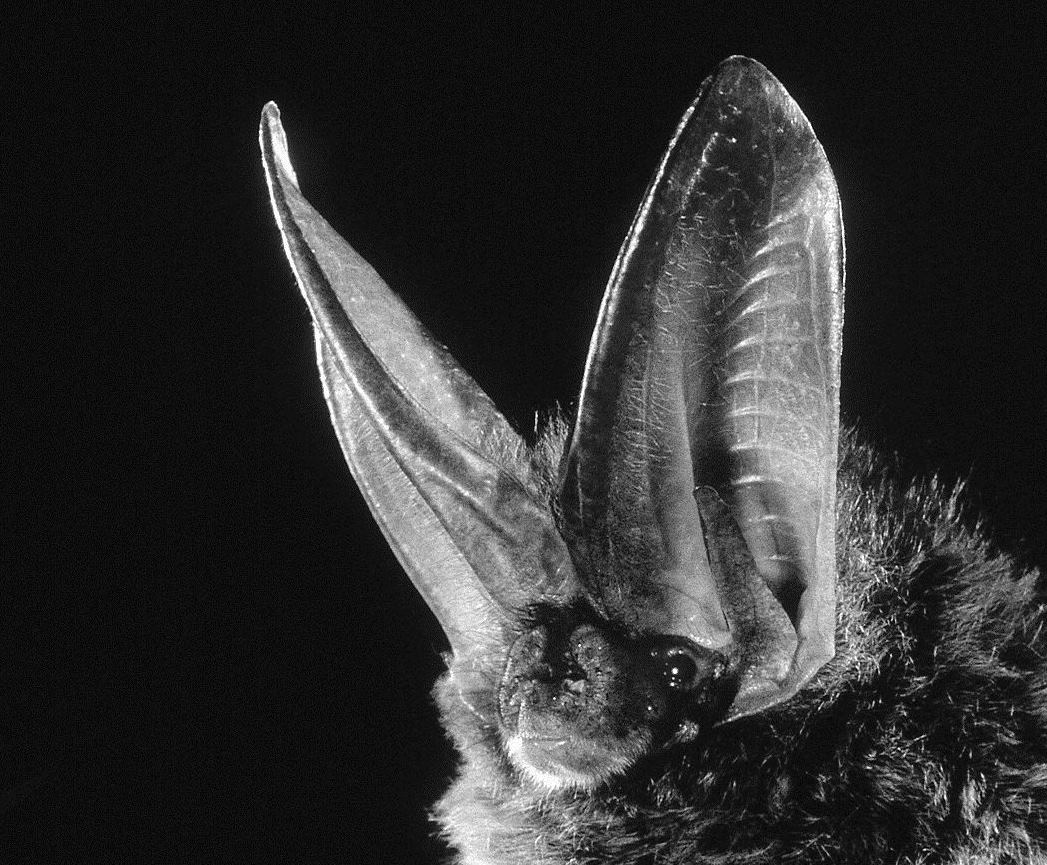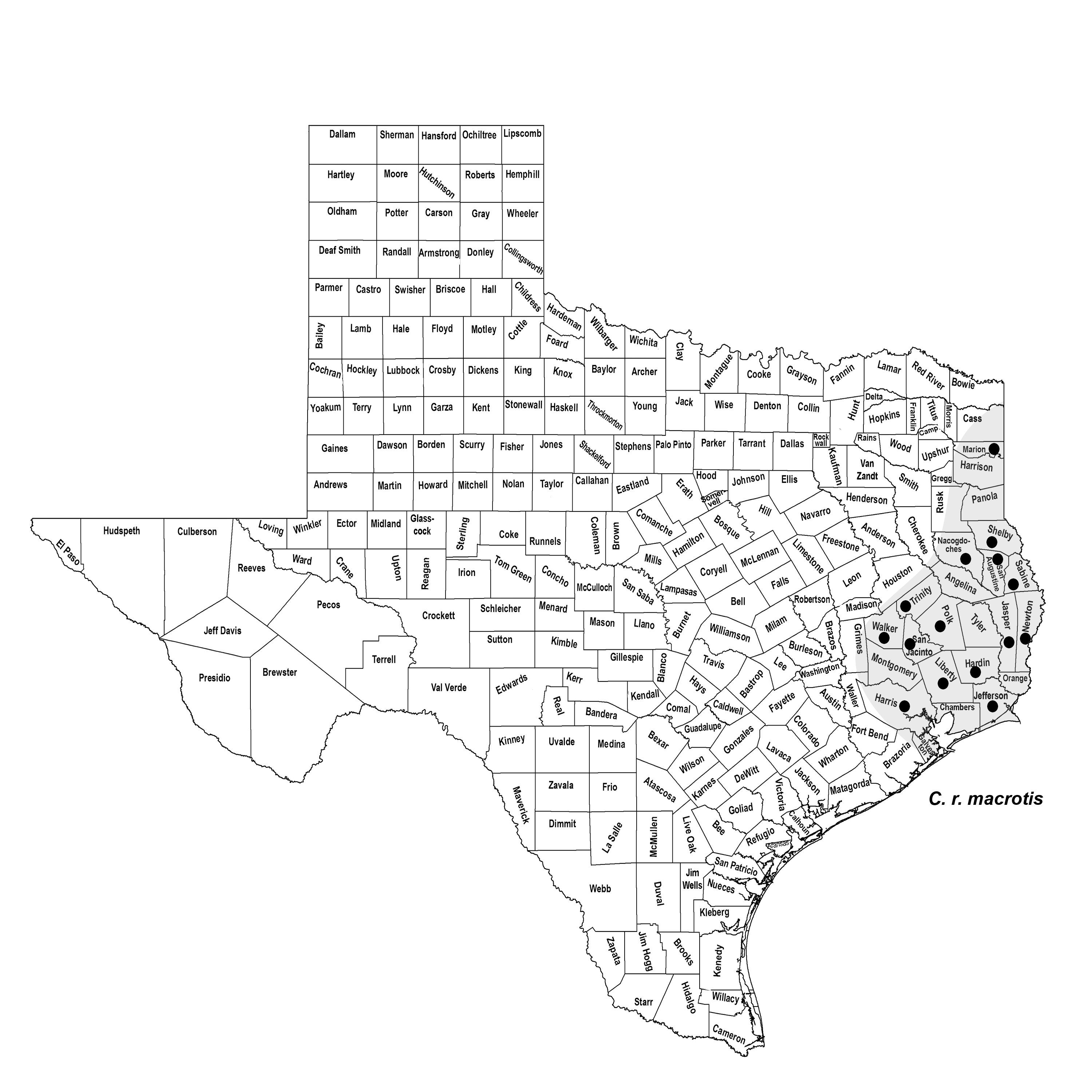RAFINESQUE'S BIG-EARED BAT
Corynorhinus rafinesquii (Lesson 1827)
Order Chiroptera : Family Vespertilionidae
DESCRIPTION. Similar to Townsend's big-eared bat but hairs of the underparts have white tips that contrast sharply with the dark bases; long hairs on foot project noticeably beyond the ends of the toes; middle upper incisors with a secondary cusp; median postpalatal process triangular in shape with a broad base. Dental formula: I 2/3, C 1/1, Pm 2/3, M 3/3 × 2 = 36. Averages for external measurements: total length, 100 mm; tail, 46 mm; foot, 12 mm; forearm, 43 mm. Weight, 7–13 g.

DISTRIBUTION. A bat of the forested areas of the southeastern United States, Rafinesque's big-eared bat reaches the westernmost portion of its range in extreme eastern Texas where it is found in small numbers at scattered localities in the Pineywoods. Captures have been recorded from May through December. Two winter roosts have been located, but it is not known whether this species hibernates there or migrates elsewhere during this season.

SUBSPECIES. Corynorhinus r. macrotis.
HABITS. Unlike the closely related C. townsendii, Rafinesque's big-eared bat occurs in forested regions largely devoid of natural caves. Its natural roosting places are in hollow trees, crevices behind bark, and under dry leaves. It has been observed most frequently in buildings, both occupied and abandoned. Texas specimens have been captured in barns and abandoned wells. Corynorhinus rafinesquii appears to be a solitary bat, although colonies of 2–100 may be encountered in summer. Winter aggregations, usually of both sexes, are more numerous, but even then solitary individuals are frequently found. The bats probably do not hibernate in East Texas, but in the northern part of their range they tend to seek out underground retreats and hibernate through the winter.
Corynorhinus rafinesquii emerges from its daytime roost well after dark to forage. Specific food items have not been recorded, but small, night-flying insects, especially moths, are probably important.
The single young is born in late May or early June; they shed their milk dentition by mid-July and reach adult size and appearance in August or September. These bats are long-lived, with a maximum recorded age of 10 years.
POPULATION STATUS. Rare, year-round resident. One of the rarest bats in the state, there are fewer than 50 specimen records from Texas.
CONSERVATION STATUS. The IUCN status of Rafinesque's big-eared bat is least concern. It currently is not listed by USFWS, but previously it had been considered as a candidate species. In Texas it is currently listed by TPWD as threatened. This bat bears special watching because of its scarcity, the lack of knowledge about its population levels, and the considerable potential that exists for degradation of roosting and feeding sites by commercial logging practices in its preferred habitat. There is a real need to determine the effects of modern timber management practices on this species as these bats appear to be extremely sensitive to human disturbance at their roost sites, which could negatively impact their population.
REMARKS. In previous editions of The Mammals of Texas, the New World big-eared bats were arranged in the genus Plecotus. In 1992 Darrel Frost (American Museum of Natural History) and Robert Timm (University of Kansas) reported the results of an analysis of 25 morphological and 11 karyological characters that support separate generic status for Corynorhinus, and this conclusion was supported by genetic sequence analyses conducted by Steven Hoofer and Ronald Van Den Bussche of Oklahoma State University. Consequently, in the 2004 edition as well as in this version of the book, we have followed this taxonomic arrangement.
From The Mammals of Texas, Seventh Edition by David J. Schmidly and Robert D. Bradley, copyright © 1994, 2004, 2016. Courtesy of the University of Texas Press.
Natural Science Research Laboratory
-
Address
Museum of Texas Tech University, 3301 4th street, Lubbock, TX 79409 -
Phone
806.742.2486 -
Email
nsrl.museum@ttu.edu

